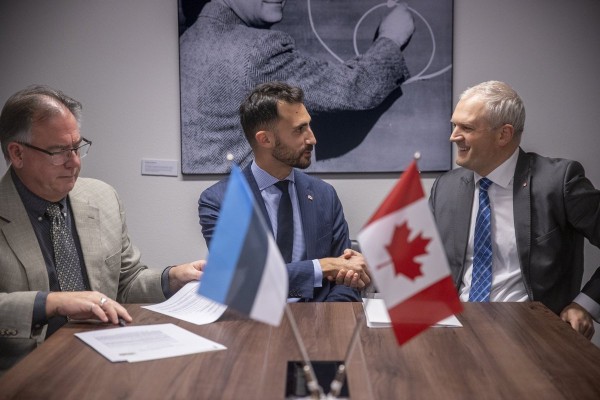David J. Smith*, Tabula, February 21-27
Japanese Foreign Minister Seiji Maehara got as frigid a reception on his February 11-12 Moscow visit as anyone has gotten since the coldest days of the Cold War. Russo-Japanese relations are in a deep freeze over Moscow’s 65 year occupation of Japan’s Northern Territories—four islands called Etorofu, Kunashiri, Shikotan and the Habomai Rocks. Moscow says they are part of Russia’s Kuril Islands and does not want to talk about it.
But Moscow does want to shout about it. Last summer, Russian General Staff Chief Nikolay Makarov tried to reassure Russia’s Baltic and Black Sea neighbors over its quest to buy French Mistral amphibious assault ships. "We need this ship,” he explained, “to increase the maneuverability of troops in the Pacific Ocean, considering the size of this geographical region and the lack of adequate forces to protect, in particular, the Kuril Islands."
Of course, no one in Tallinn or Tbilisi should breathe easier. Under the January 25 Franco-Russian agreement, a contemptible shipbuilding consortium will supply Russia with four Mistral class ships—likely one for each of the Baltic, Black Sea, Northern and Pacific fleets.
And the Mistral revelation was not Moscow’s last shout about the Kuril Islands. In September, Russian President Dmitry Medvedev visited China. In Beijing, he and Chinese President Hu Jintao signed a curious statement on the 65th anniversary of the end of World War II, which framed a joint image of the 1945 victory of Japan. Of course, that victory also established the United States as the dominant power in the western Pacific.
Two points emerge from this joint historical exegesis. First, Moscow and Beijing are making common cause in their territorial claims against Japan—Russia over the Northern Territories or Kurils; China over the Senkaku Islands, some hydrocarbon-rich rocks between Okinawa and Taiwan. Second, both resent American Pacific power, for which they perceive Japan as a surrogate.
And a further observation emerges from a broader look at Medvedev’s China visit. He and Hu signed 15 agreements on energy, banking and fisheries and inaugurated the Eastern Siberia – Pacific Ocean oil pipeline spur that now reaches Daqing, China. Then Medvedev visited the Shanghai World Expo trade fair.
China is Russia’s number one trade partner, behind only the entire European Union. Just as the world’s gaze is shifting toward the Pacific, so is Russia’s. Moreover, as global warming opens up the Arctic Northeast Passage to shipping between Europe and Asia, a strong Russian Pacific presence becomes very attractive.
But Moscow’s view to the Pacific is bleak. Vladivostok is 9,302 rail kilometers away, most of them through tough terrain and climate. Only 25% of Russia’s people live in Asia, and the population is declining. And Vladivostok is not Busan, Yokohama or Shanghai. Kunashiri is a metaphor for Russia’s rickety rule over frigid bits of Pacific coastline. The answer—guns, bravado and blather about inexistent threats.
So, as Medvedev left China, he announced his plan to be the first ever Soviet or Russian chief to visit the Kuril Islands. On November 1, he arrived on Kunashiri. During his well-televised visit, he met with resident families, peered out to sea through binoculars and frolicked among rusted Stalin-era tanks.
Japanese Prime Minister Naoto Kan grumbled, "Those four northern islands are part of our country's territory, so the president's visit is very regrettable," and Tokyo recalled its ambassador to Moscow.
Russian Foreign Minister Sergey Lavrov retorted, “The Kuril Islands are part of Russian territory and belong to the domain of home policy. The president plans his domestic travels himself.”
Then, in a February 9 television broadcast staged for the president to appear tough, Medvedev issued stern instructions to Russian Defense Minister Anatoly Serdyukov. "The additional weapons which will be deployed there must be sufficient and modern to ensure the security of these islands, which are an inseparable part of the Russian Federation…We will make every necessary effort to strengthen our presence on the Kuril Islands. This is our strategic region."
Two days earlier, in Japan, it had coincidentally been Northern Territories Day. Sparked by heightened Russian belligerence, Japanese nationalists dragged a Russian flag through Tokyo streets. And Kan denounced Medvedev’s visit to Kunashiri as an “unforgivable outrage.”
Naturally, Moscow seized upon this as an excuse for its aggressive attitude and new fortifications. The flag incident, said the Russian Foreign Ministry, was an "unprecedented and disgusting act," resulting from Japanese policies. When Maehara landed in Moscow, the rhetorical trap had been laid. Lavrov—the quintessential aggrieved aggressor—sneered, "To be honest…your visit comes against the background of a series of completely unacceptable actions.”
In reality, Moscow prepared its tiff with Tokyo for some time, following an altogether familiar pattern—expansionism, paranoia, pretext, military action and righteous indignation. Although the details differ, anyone familiar with Russia’s 2008 attack on Georgia will recognize Moscow’s Kuril caper for what it is.
As this magazine goes to press, Senior Russian General Staff officers tell RIA-Novosti that Moscow will deploy S-400 air defense missiles in the Japanese Northern Territories, which Russia says are part of its Kuril Islands. The S-400 is an upgraded version of the S-300, which is deployed by Russian occupation forces in the Georgian territory of Abkhazia.
(http://www.gfsis.org/media/dow... )
*David J. Smith is Director, Georgian Security Analysis Center, Tbilisi, and Senior Fellow, Potomac Institute for Policy Studies, Washington.
Moscow's Kuril Caper
Arvamus
TRENDING
























